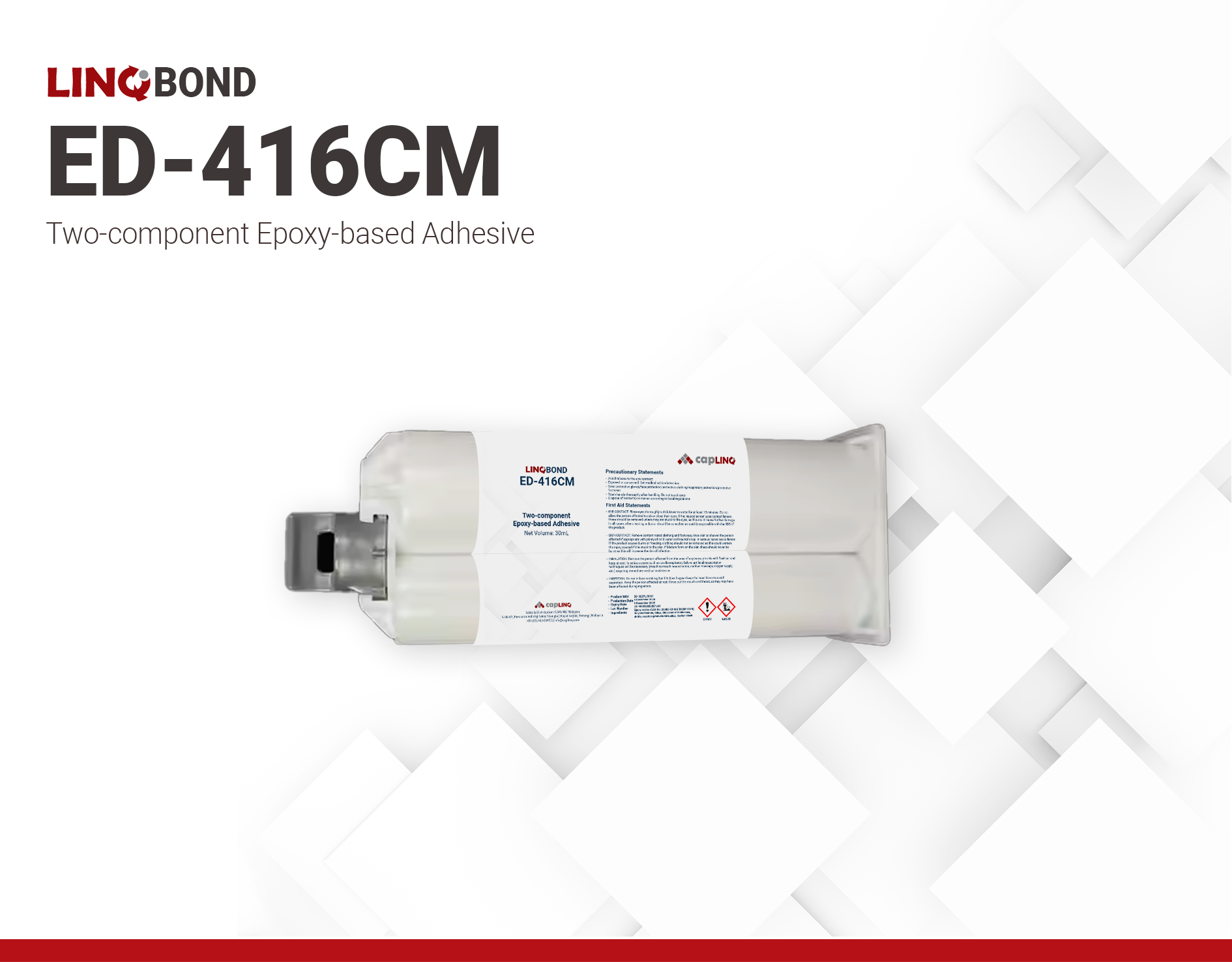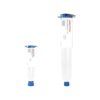LINQBOND ED-416CM | Two-component Epoxy Adhesive
Harmonization Code : 3907.30.00.15 | Epoxide resin, halogen-free
Main features
- No surface treatment required
- Excellent chemical resistance
- Zero solvent formulation
Product Description
LINQBOND ED-416CM is a rapid-curing, two-component epoxy adhesive designed to deliver high strength, chemical resistance, and efficient processing for a wide range of bonding applications. Achieving handling strength within 20 minutes, LINQBOND ED-416CM significantly reduces working time, improving manufacturing efficiency.
LINQBOND ED-416CM exhibits strong adhesion to plastics, metals, and electronic components, making it ideal for structural bonding, sealing, and general-purpose applications. Its excellent resistance to chemicals, solvents, and moisture ensures reliable performance in demanding environments. The adhesive is easy to mix, RoHS 2011/65/EU compliant, and cures effectively at room temperature.
Applications
- Bonding and caulking of plastics, metals, and electronic assemblies
- General industrial adhesives for fast, reliable room-temperature bonding
- Sealing applications requiring chemical and solvent resistance
- High-speed assembly processes requiring short handling times
Technical Specifications
| General Properties | |||||
| Mix Ratio Mix Ratio The amount of a constituent divided by the total amount of all other constituents in a mixture | 1:1 | ||||
| Specific Gravity Specific Gravity Specific gravity (SG) is the ratio of the density of a substance to the density of a reference substance; equivalently, it is the ratio of the mass of a substance to the mass of a reference substance for the same given volume. For liquids, the reference substance is almost always water (1), while for gases, it is air (1.18) at room temperature. Specific gravity is unitless. | 1.22 | ||||
| |||||
| Chemical Properties | |||||
| Water Absorption | 1.26 % | ||||
| Mechanical Properties | |||||
| |||||
| Electrical Properties | |||||
| Surface Resistivity | 5e14 Ohms/sq | ||||
| Volume Resistivity Volume Resistivity Volume resistivity, also called volume resistance, bulk resistance or bulk resistivity is a thickness dependent measurement of the resistivity of a material perpendicular to the plane of the surface. | 5.0x1015 Ohms⋅cm | ||||
| Thermal Properties | |||||
| |||||
| Degradation temperature Degradation temperature The temperature at which the materials start losing their properties | 325 °C | ||||
| Glass Transition Temperature (Tg) Glass Transition Temperature (Tg) The glass transition temperature for organic adhesives is a temperature region where the polymers change from glassy and brittle to soft and rubbery. Increasing the temperature further continues the softening process as the viscosity drops too. Temperatures between the glass transition temperature and below the decomposition point of the adhesive are the best region for bonding. The glass-transition temperature Tg of a material characterizes the range of temperatures over which this glass transition occurs. | 40 - 49 °C | ||||
| Specific Heat Capacity Specific Heat Capacity Specific heat capacity is the amount of heat energy required to raise the temperature of a substance per unit of mass. The specific heat capacity of a material is a physical property. It is also an example of an extensive property since its value is proportional to the size of the system being examined. | 5.424 J/(g⋅°C) | ||||
| Other Properties | |||||
| RoHS Compliant RoHS Compliant RoHS is a product level compliance based on a European Union Directive which restricts the Use of certain Hazardous Substances in Electrical and Electronic Equipment (RoHS). Products compliant with this directive do not exceed the allowable amounts of the following restricted materials: lead, mercury, cadmium, hexavalent chromium, polybrominated biphenyls (PBB) and polybrominated diphenyl ethers (PBDE), with some limited exemptions | Yes | ||||
Additional Information
Typical Curing Properties
| Property | Magnitude | Units |
| Mix rate (A:B) by weight | 1:1 | - |
| Surface Dry Time @25℃ | 5 - 10 | min |
| Full Cure Time @25℃ | 3 - 4 | days |
Uncured Properties
| Property | Part A | Part B | Unit |
| Appearance | Liquid | Liquid | — |
| Color | Milky | Light Yellow | — |
| Viscosity @25℃ | 100,000 - 200,000 | 17,000 - 32,000 | cP |
| Thiotropic Index | 3.25 | 3.7 - 4.1 | — |
| Specific Gravity | 1.16 | 1.11 | — |
Directions for Use
- The adhesive should be applied on clean surface that is free of dirt, grease, or mold release. In the case that it is coated with such, a simple solvent wipe will suffice.
- Mix thoroughly by weight (1:1 mix ratio) prior to use.
- After mixing the two parts, the adhesive should be used within its pot life. Large quantity mixing is not recommended for this product.
- For maximum bonding strength, apply the adhesive evenly to both surfaces that will be joined together.
- For handling information, refer to the attached Technical Data Sheet




